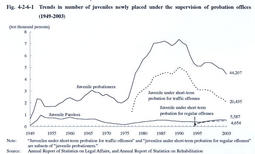| Previous Next Index Image Index Year Selection | |
|
|
2. Trends in number of juvenile probationers/parolees Fig. 4-2-6-1 shows the number of juvenile probationers and parolees newly placed under the supervision of probation offices since1949.
Fig. 4-2-6-1Trends in number of juveniles newly placed under the supervision of probation offices(1949-2003) The number of juvenile probationers newly placed under the supervision of probation offices increased drastically since1977when short-term probation for traffic offenses was introduced.It remained at around70,000since1983but decreased from1991until1995.Although it increased slightly from1996until1998due to the implementation of short-term probation for regular offenses introduced in1994,it has decreased again since1999to44,207in2003,a decline by4,436(9.1%)from the previous year.Breaking it down by type of treatment,20,435juveniles were placed under short-term probation for traffic offenses(down by2,899or12.4%from the previous year),4,654were placed under short-term probation for regular offenses(down by129or2.7%),and19,118were placed under other types of probation(down by1,408or6.9%).The number of parolees from juvenile training schools had increased until1985,due partly to the introduction of short-term treatment programs in juvenile training schools in1977.After that,it generally decreased until1996but increased from1997to2002.In2003,however,it decreased by261(4.5%)from the previous year to5,587(see Appendix2-13 ). |
